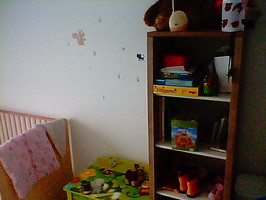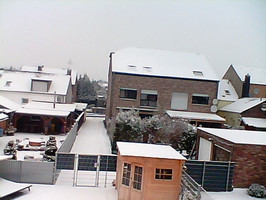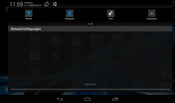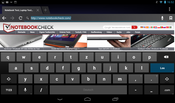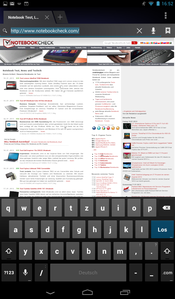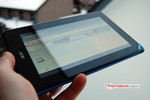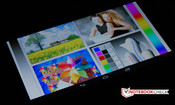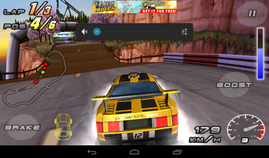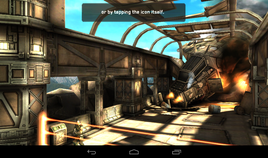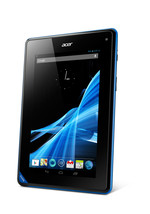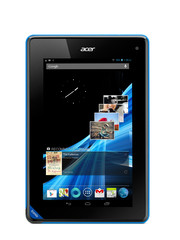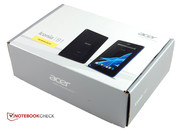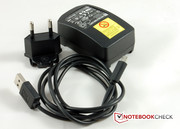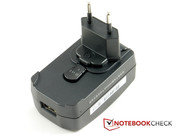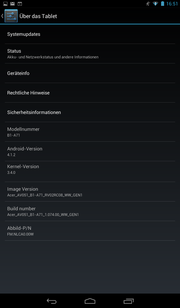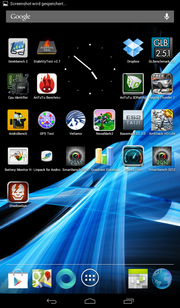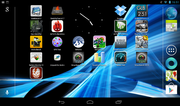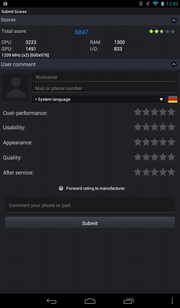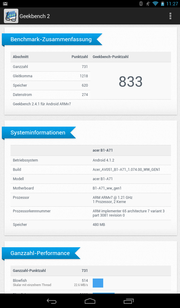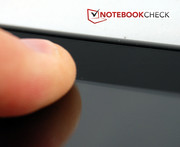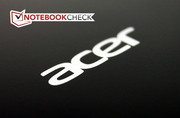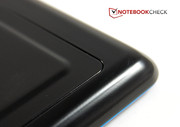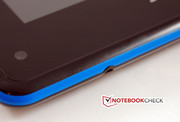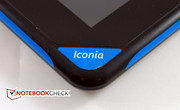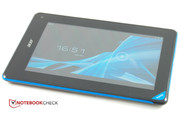Review Acer Iconia B1-A71 Tablet

For the original German review, see here.
The tablet market is all set to explode if it still hasn’t. Hardly a day passes where a new model is not announced. Most of the action in at the low end of the tablet where many manufacturers are trying to make money by selling large quantities of cheap tablets. We have had a large number of these cheap tablets hit our office coming at unheard prices of 130 Euros to 150 Euros (~$175 to $200). However, almost none of the devices came from well-known brands. The tablets were from companies like Trekstor, Pearl, Prestigo and cmx. Acer is the first big name that is trying its hand at making an ultra-cheap tablet. The PR coming out of Acer for the tablet mentions it to be light, handy and powerful. The biggest feature of the tablet is the excellent price of 120 Euros (~$160) which makes it an extremely attractive product if the other touted features are as good as what Acer makes them out to be. We have not tested a good cheap tablet and we find ourselves to be extremely curious about this offering.
The technical specifications sound promising, at least in the beginning. The 7-inch tablet is powered by a 1.2 GHz dual-core CPU with Cortex A9 cores from MediaTek, supported by a PowerVR SX531 graphics chip from Imagination. Both are certainly not the most powerful components, but they aren't bottom of the barrel either. The working memory is 512 MB and the 8 GB internal memory can be expanded with a microSD card. Google's Nexus 7, which happens to this tablet’s main rival, does not provide this option. The Nexus 7 and the Galaxy Tab 7.7 made the 7-inch form factor very popular. But the caveat is the resolution of 1024 x 600 pixels which is pretty low compared to the other (more expensive) tablets. Acer promises 70 degree viewing angle stability from every direction. To date, Acer's Iconia B1 is available in a Wi-Fi only version. Whether a 3G version will follow is not yet certain.
Case
Acer's Iconia B1 is not one of the smallest 7-inch tablets out there, with dimensions of 197.4 and 128.5 millimeters. It is thicker than most other tablets at 11.3 mm. BUt the tablet is extremely light at only 320 g that makes it very comfortable to hold.
It is very obvious that Acer made several cut-backs in its choice of materials for construction and the build quality to keep the price of the product down. With exception of the screen panel, the entire device is made of cheap plastic which also affects the tablet's stability. Light pressure is all that is needed to deform the body of the tablet (with ripples on the screen when the back is pressed in). This is also accompanied by creaking noises that would scare any user. The screen can be pushed in at the edges that creates a gaping space between the panel and the bezel. Acer's Iconia B1 build quality cannot be compared to the build quality of devices like Google's Nexus 7 and the Prestigio MultiPad 7.0.
Although the manufacturer dubs the color "Midnight Black", the tablet is completely framed by a blue border. The tablet looks like a toy and would most probably be used for the entertainment of kids. The price is low enough to make it an impulse buy for many customers.
Connectivity
The connectivity options on the Acer Iconia B1 looks rather sparse compared to more expensive, premium tablets. But you also need to consider the price at which the tablet is being sold. A Cortex A9 based dual-core processor is not seen often in this price range. 512 MB of memory and 8 GB of internal storage are also appropriate especially since the latter can be inexpensively expanded up to 32 GB using a microSD card. The usual interfaces are found on the tablet. Among them, a micro USB port that is used for charging but not as a USB-OTG host and a 3.5 mm combo jack for a headphone or microphone. There is also a camera on the front, but more about that a little later.
Software
Google's Android 4.1.2 aka Jelly Bean is as up-to-date as it gets if the device is not labeled Google Nexus. We have to praise Acer highly for this. Jelly Bean is a much more polished product compared to the Ice Cream Sandwich version that was available on the lower proced devices. Moreover, Jelly Bean includes Google Now and other up-to-date operating system extensions like the personal assistant and new speech functions. It is possible to work quite smoothly with the Iconia B1 for normal workloads. The menu responds quickly and reliably and jerks while scrolling through long lists are rare. Apps also open agreeably fast although more sophisticated apps like games need a bit longer to load. The entry-level hardware performance is obvious when it comes to internet browsing. Rendering websites simply takes a bit longer than usual. However, we did not find this annoying.
Communication & GPS
Acer's entry-level tablet is well-equipped for wireless communication. Wi-Fi standard 802.11 b/g/n and Bluetooth 4.0 are available. It is no surprise that Acer does not install a dual-Wi-Fi antenna for 2.4 and 5 GHz networks in view of the price range. Many providers omit a GPS sensor, but fortunately Acer does not. While the Wi-Fi adapter works reliably and has sufficient range, the GPS sensor is not one of the strengths of the Acer Iconia B1. The initial sat-fix needs over a minute, even outdoors. The tablet also quickly loses the satellite connection in heavily overcast conditions or in the woods. Nevertheless, it is quite suitable for navigating through streets.
Cameras & Multimedia
Entry-level tablets usually do not sport useful cameras and Acer is no exception. More than a VGA sensor with 0.3 megapixels is not possible for this price. It positioned to the front and the quality is sufficient for the odd video call.
The 0.3 MP camera is not suitable for shooting pictures. First, because it is placed on the front, which actually only enables taking self-portraits. Second, the image quality is out of question because the pictures are very blurry and exhibit many artifacts. The pictures are perhaps still acceptable as snapshots in bright ambient light. In low light, dark areas are completely blackened, the image exhibits severe noise and the content partly becomes unrecognizable.
The tablet is not much better as a video camera. VGA clips clearly lack focus. Moreover, the sensor needs quite a long time to readjust in case of sudden brightness changes. In our opinion, Acer could have omitted the camera.
Accessories
The offering is sparse at best. Apart from the compulsory PSU and micro USB cord, which is also used for recharging, merely a quite comprehensive quick start guide and warranty conditions in paper form are found in the box.
Warranty
Acer includes a 12 month warranty on its entry-level tablet, which covers "International Travelers". In Germany, a 24 month statutory warranty is also included.
Input Devices & Controls
The user experience on the Acer does not differ from other tablets in the same price range. Besides the usual power and volume buttons on the casing, whose functionality we found to be good, the three obligatory Android controls "Back", "Home" and "Recent" are software based present on the screen. However, the main control feature of Acer's Iconia B1 is also the capacitive touchscreen that detects gestures with up to five fingers. The screen does its job well and is much better than other cheap tablets like the Archos 101 XS and the Braun B-Tab 711. We had no misbehavior from the touch screen like we found on the Archos tablet. Overall, the touchscreen responds quickly and reliably to inputs and multiple taps are not necessary. Frequently used gestures like pinch-to-zoom and tap-to-zoom work flawlessly. The touchscreen's quality impressed us a lot in view of the device price range. More often than not, this is a major issue in the entry-level sector and an inferior touchscreen ruins the fun of using a tablet.
Automatically rotating screen content according to the holding position worked perfectly, although the tablet always needed a moment longer, which really only took about one second. Screen rotation can also be disabled using a small slider option at the top of the notification bar.
Display
7 inches is the magic number for a portable device that can be considered to make a decent tablet. The leaders Apple and Google paved the way with their iPad Mini and Nexus 7 tablets for the hype around this device category, which are both genuine premium tablets within different price ranges. Google's Nexus 7 excels with its HD resolution despite the low price. The iPad cannot compete with that and Acer's Iconia B1-A71 remains discreetly in the background with a resolution of 1024 x 600 pixels. This WSVGA resolution leads to a rather unusual aspect ratio of 17:10. The pixel density is merely 170 ppi. For comparison: The Google Nexus 7 achieves a density of 216 ppi, which is good 27 percent higher. Remarkably, the 162 ppi of Apple's iPad Mini does not come close to the Acer although it is three times as expensive.
Not as remarkable, though positive, is the 7-inch screen's brightness. We ascertained a maximum brightness of 200 cd/m² in the center, which is not really a good number for a tablet. However, the uneven illumination of just 68 percent has much more significance. The gauge recorded just 135 cd/m² in the upper left corner. This difference is visible with the naked eye. On the other hand, the low black value of 0.27 cd/m² appealed to us and results in a decent contrast of 741:1 despite the low brightness.
| |||||||||||||||||||||||||
Brightness Distribution: 68 %
Center on Battery: 200 cd/m²
Contrast: 741:1 (Black: 0.27 cd/m²)
It is evident at first glance that Acer uses a TN screen in its entry-level tablet. However, an IPS or OLED screen cannot be expected considering the price range in which it is offered. The contrast is adequate owing to the low black value in any case. In our opinion, the colors could be a bit brighter and the image is not always razor-sharp - this particularly applies to small fonts. Basically, the picture quality is satisfactory.
Our feelings about using the Iconia outdoors is mixed at best. It is quite suitable for mobile use due to its compact dimensions and low weight. However, the screen ruins outdoor fun in two ways. First, the glass surface is extremely reflective and smears are visible after a short time of use. Second, the mediocre brightness and extreme viewing angle dependency restricts use in the sun.
The screen in the Acer Iconia Tab B1 is based on the very outdated TN technology. The user will notice this particularly in the viewing angles. The horizontal viewing angle stability is still quite tolerable. Vertical viewing angles are poor. The contrast quickly decreases when looking upward. However, the content remains legible up to approximately 70 degrees of tilt. After this, the colors invert when looking down at more acute angles. The content is beyond recognition in this case.
Performance
The buyer cannot expect a high-performance machine for 120 Euros. However, when drawing parallels to the automotive sector, the buyer must get a sufficiently powerful vehicle that can deal with normal, everyday requirements in all situations even in the entry-level sector. That should not be different for tablets. Our experience however has taught us the opposite many a time.
Acer's Iconia Tab B1 makes a reasonable impression on paper. The system-on-a-chip (SoC) dubbed MediaTek MTK 8317T fuses a dual-core processor with Cortex A9 cores and a single-core GPU from Imagination called the PowerVR SGX531. The processor cores are clocked at 1.2 GHz each and are technically modern. Although there are stronger Cortex cores, the A9 is still built into high-end tablets. But, the single-core graphics chip is no longer relevant when compared to the latest chips.
With 833 points in the cross-platform benchmark GeekBench 2, the Acer Iconia B1 places itself in the lower section of the tablets tested to date by notebookcheck.com. This is quite decent. It even marginally outperforms the Apple iPad Mini and places itself ahead of other entry-level tablets like the Braun B-Tab 711. AnTuTu v3 confirmed this result in the overall score. AnTuTu's benchmarks also generally achieved the same results in the CPU, GPU and RAM parts.
An interesting aspect in the performance assessment is also the internal memory's performance. We used AndroBench 3 to test this. The B1 also looked quite impressive here, although we have doubts about the very high sequential read score. In any event, Acer has not made excessive cutbacks in the quality of the internal memory.
| Smartbench 2012 - Productivity Index (sort by value) | |
| Acer Iconia B1-A71 | |
| Google Nexus 7 | |
| Prestigio MultiPad 7.0 Prime Duo (PMP5770D) | |
| Toshiba AT270-101 | |
| Linpack Android / IOS - Multi Thread (sort by value) | |
| Acer Iconia B1-A71 | |
| Google Nexus 7 | |
| Prestigio MultiPad 7.0 Prime Duo (PMP5770D) | |
| Braun B-Tab 711 | |
| Apple iPad mini | |
| Toshiba AT270-101 | |
| Geekbench 2 - 32 Bit - Total Score (sort by value) | |
| Acer Iconia B1-A71 | |
| Google Nexus 7 | |
| Prestigio MultiPad 7.0 Prime Duo (PMP5770D) | |
| Braun B-Tab 711 | |
| Apple iPad mini | |
| Toshiba AT270-101 | |
| AndroBench 3-5 | |
| Random Write 4KB (sort by value) | |
| Acer Iconia B1-A71 | |
| Google Nexus 7 | |
| Prestigio MultiPad 7.0 Prime Duo (PMP5770D) | |
| Braun B-Tab 711 | |
| Toshiba AT270-101 | |
| Random Read 4KB (sort by value) | |
| Acer Iconia B1-A71 | |
| Google Nexus 7 | |
| Prestigio MultiPad 7.0 Prime Duo (PMP5770D) | |
| Braun B-Tab 711 | |
| Toshiba AT270-101 | |
| Sequential Write 256KB (sort by value) | |
| Acer Iconia B1-A71 | |
| Google Nexus 7 | |
| Prestigio MultiPad 7.0 Prime Duo (PMP5770D) | |
| Braun B-Tab 711 | |
| Toshiba AT270-101 | |
| Sequential Read 256KB (sort by value) | |
| Acer Iconia B1-A71 | |
| Google Nexus 7 | |
| Prestigio MultiPad 7.0 Prime Duo (PMP5770D) | |
| Braun B-Tab 711 | |
| Toshiba AT270-101 | |
| AnTuTu v3 | |
| CPU (sort by value) | |
| Acer Iconia B1-A71 | |
| Google Nexus 7 | |
| Braun B-Tab 711 | |
| GPU (sort by value) | |
| Acer Iconia B1-A71 | |
| Google Nexus 7 | |
| Total Score (sort by value) | |
| Acer Iconia B1-A71 | |
| Google Nexus 7 | |
| Braun B-Tab 711 | |
| RAM (sort by value) | |
| Acer Iconia B1-A71 | |
| Google Nexus 7 | |
| Braun B-Tab 711 | |
Next we looked at the graphics performance. For this, it had to pass through AnTuTu's 3DRating and GLBenchmark 2.5.1. Regrettably, only the on-screen test worked with the tablet's native resolution in the latter. The off-screen test using the native resolution would be more comparable. The achieved 2.5 fps nevertheless clearly show that the graphics chip is low-end. AnTuTu's test also confirmed this.
| GLBenchmark 2.5 - Egypt HD Fixed Time (sort by value) | |
| Acer Iconia B1-A71 | |
| Google Nexus 7 | |
| Prestigio MultiPad 7.0 Prime Duo (PMP5770D) | |
| Braun B-Tab 711 | |
| Apple iPad mini | |
| Toshiba AT270-101 | |
The Acer Iconia B1 can be used for routine tasks like running Paint or Internet browsing rather than a gaming machine. We checked the tablet's performance in this category with browser-based tests. One of the best known benchmarks is Sunspider version 0.9.1 Java-script test. The B1 scored remarkably well here. With just 1395 milliseconds, it even outperforms much stronger devices like the Google Nexus 7. Other low-budget tablets like the Braun B-Tab 711 are completely beaten. The benchmarks Peacekeeper and Google v8 recorded the same results. Acer's tablet also impresses with above-average performance here and proves that Internet surfing is its purpose. However, it did not score quite as well in Browsermark 2. Nevertheless, its browser performance is generally good. And considering the price, there is absolutely nothing to complain about.
| Google V8 Ver. 7 - Google V8 Ver. 7 Score (sort by value) | |
| Acer Iconia B1-A71 | |
| Google Nexus 7 | |
| Prestigio MultiPad 7.0 Prime Duo (PMP5770D) | |
| Braun B-Tab 711 | |
| Apple iPad mini | |
| Toshiba AT270-101 | |
| Sunspider - 0.9.1 Total Score (sort by value) | |
| Acer Iconia B1-A71 | |
| Google Nexus 7 | |
| Prestigio MultiPad 7.0 Prime Duo (PMP5770D) | |
| Braun B-Tab 711 | |
| Apple iPad mini | |
| Toshiba AT270-101 | |
| Browsermark - --- (sort by value) | |
| Acer Iconia B1-A71 | |
| Google Nexus 7 | |
| Apple iPad mini | |
| Peacekeeper - --- (sort by value) | |
| Acer Iconia B1-A71 | |
| Google Nexus 7 | |
* ... smaller is better
Games
We already mentioned about the installed graphics solution in the course of this review. Acer's Iconia B1 with the PowerVr SGX531 is certainly not a gaming tablet. Nevertheless, the performance is sufficient for most games. Popular games like Angry Birds and Air Attack HD are no problem for the tablet. Even more demanding racing simulations like Raging Thunder 2 and Need for Speed: Hot Pursuit ran smoothly for the most part. The third person shooter ShadowGun was also playable. However, we can verify that the GPU is limited in its ability to play more modern titles. We can certainly say that future titles designed for tablets having SOCs based on the 28 nm process would be unplayable.
Emissions
Temperature
Acer's Iconia B1 definitely does not have thermal problems. This would be due to its middling performance components compared to premium tablets. The surface temperatures were always within a tolerable range. Even hour-long loaded runs for the Stability Test did not let the temperatures exceed 38 degrees Celsius. The power supply unit also remained within an acceptable temperature range at a relatively cool 41 degrees Celsius. The temperatures remained even lower in routine use. The device only gets lukewarm at a few measuring points.
(+) The maximum temperature on the upper side is 38.1 °C / 101 F, compared to the average of 33.8 °C / 93 F, ranging from 20.7 to 53.2 °C for the class Tablet.
(+) The bottom heats up to a maximum of 35.2 °C / 95 F, compared to the average of 33.3 °C / 92 F
(+) In idle usage, the average temperature for the upper side is 28.4 °C / 83 F, compared to the device average of 30 °C / 86 F.
Speakers
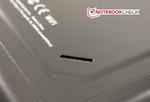
Acer's Iconia B1 sports one small speaker that is installed on the rear towards the lower right. It is actually more of a tiny noise maker that croaks quite loudly when the volume is turned up. It simply lacks saturated sound and dynamics for enjoying music. A headphone is regrettably not included.
Energy Management
Power Consumption
According to Acer, a 2720 mAh lithium ion battery is installed in the tablet. The battery is one of the smaller ones in the 7-inch tablet form-factor. The power consumption in different load scenarios is crucial for the battery life though. A power consumption between 1.2 and 3.1 watts is pretty good for such a device. For comparison, the Apple iPad Mini consumes up to 5.6 watts here. However, it also features a much brighter screen. The power consumption climbed up to 6.2 watts during load. This is still reasonable although not very economical in view of the entry-level SoC.
| Off / Standby | |
| Idle | |
| Load |
|
Battery Runtime
The comparatively low power consumption stirs hope for good battery runtimes despite the small battery. We performed three runtime tests in different load states. The maximum battery runtime is ascertained using server-side scripting, which is automatically opened using minimum brightness and, except for Wi-Fi, all communication modules turned off. Acer's entry-level tablet lasted for a good 12 hours in this scenario and is one of the best for a 7-inch device. Devices like the Apple iPad Mini and the Google Nexus 7, are in a league of their own.
The minimum battery runtime during full CPU and GPU load was a decent 2:51 hours. Our Wi-Fi surf test, using a brightness of 150 cd/m², is particularly important. Here, a new website is opened every 40 seconds. Acer's Iconia B1 runs for almost five and a half hours and again places itself at the top of the list with this result. However, it is far from reaching the 12 hours achieved by Apple's iPad Mini.
Altogether, Acer's B1 scores with good battery runtimes. We have not observed this in many devices in this price range yet. The 10 watt power supply unit needed a bit over two hours to completely recharge the battery.
Verdict
Kudos to Acer! It was clear right from outset of this review that the Acer Iconia B1 was not fighting for a crown in the tablet market. Nevertheless, we had very high expectations for the first "low-budget" tablet from a brand manufacturer. And Acer did not let us down. The B1 is the first tablet at a price of 120 Euros (RRP) that is an attractive buy. However, it was to be expected that the buyer has to make compromises in the hardware to keep the device price down.
A price of 120 Euros is pretty obvious when you look at the workmanship and choice of materials. Acer made cutbacks here, but the price has to match the hardware or Acer would struggle with the overheads. The configuration is above-average for this price range. A SoC with a dual-core processor based on the Cortex A9 is not a matter of choice, as a look at some other low-budget devices proves. The GPU is not the newest but the choice is good. 8 GB of memory is not generous, but can be inexpensively expanded using an SD card, unlike tablets from Google or Apple. Wi-Fi, Bluetooth and GPU are also available and are the best possible for this price range. However, the GPS sensor disappointed us. The battery runtime and user experience were decent. The device does not let its user down here.
Other points of criticism? Sure, there’s plenty. The screen is based on the outdated TN technology, is not very bright and the illumination is very uneven. That could have been avoidable. The camera is, with due respect, a joke. Omitting it would have been a better solution.
All said and done, Acer fulfills its promise and provides an affordable tablet for first-time users, or as a second device or a throw-away device for the children. If these requirements fit the needs of the user, then this tablet would be a good buy. The wish for a stronger device will always be there, but for a first-time user, the device is a great learning tool.


 Deutsch
Deutsch English
English Español
Español Français
Français Italiano
Italiano Nederlands
Nederlands Polski
Polski Português
Português Русский
Русский Türkçe
Türkçe Svenska
Svenska Chinese
Chinese Magyar
Magyar




